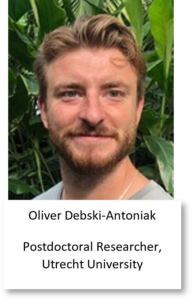September 26th 2024
CARE’s Young Researcher – Oliver Debski-Antoniak

CARE’s Young Researchers – Introducing Oliver Debski-Antoniak PhD, Utrecht University
Read about how Oliver’s work in the discovery and advancement of potential antibody treatments for both existing and emerging coronavirus infections is making a significant contribution towards efforts in prevention and alleviation of economic and health strains caused by endemics and pandemics in the future.
CARE (Corona Accelerated R&D in Europe) is the largest European research initiative addressing the challenges of COVID-19. It comprises 38 partners, from both industry and academia, in a set-up of eight multidisciplinary work-packages (WPs). In this series, we highlight the work of some of the young researchers involved in CARE as part of their PhD or postdoctoral work. Here, we learn how this opportunity has benefited Oliver, while simultaneously benefiting CARE and its ambition to help society defeat COVID-19 and future pandemics.
Why did you decide to get involved in CARE?
My decision to join the CARE consortium was driven by a profound desire to contribute to pandemic prevention and preparedness on a global scale. This aspiration led me to the virology department in Utrecht University, where I could actively participate in the groundbreaking efforts through fantastic collaborations via the CARE consortium. I was particularly inspired by the innovative work emerging from this collaboration, such as the discovery of P5C3, a highly potent antibody against SARS-CoV-2. This work, spearheaded by Craig Fenwick et al, highlighted work coming from the CARE consortium is at the leading edge of research.
Tell us about the work you have been doing in the CARE consortium
My work is centered around two primary objectives:
- The discovery and advancement of potential treatments for both existing and emerging coronavirus infections.
- Enhancing our understanding of the initial stages of both novel and known coronavirus infections, primarily through studying the structure, function, and mechanism of action of the viral spike protein, which facilitates recognition and entry into the host cell.
I apply my expertise in cryo-EM, a technique that allows me to visualize the virus directly. This method offers detailed insights into the molecular interactions between the virus and the host cell, as well as between the virus and potential therapeutic candidates, thereby revealing the virus’s vulnerabilities.
Through my contributions to the CARE consortium, several pieces of work have been published. These include the characterization of a promising cyclic peptide with potential as a pan-Sarbecovirus therapeutic. This peptide binds to a highly conserved region of the spike protein, enabling it to remain active against all SARS-CoV-2 variants of concern and neutralize other members of the Sarbecoviruses, a group of coronaviruses with the potential to cross over to humans, which could have catastrophic consequences.
We have also isolated and characterized potent monoclonal antibodies against the spike protein of Porcine Delta Coronavirus (PDCoV). PDCoV is a prevalent coronavirus in pig populations, causing significant economic impact on the porcine industry. However, PDCoV has also been found in humans in several isolated cases. This virus has considerable potential to cause future pandemics, necessitating extensive research to better understand this virus and develop therapeutics to mitigate the effects of an outbreak, should it achieve human-to-human transmission. Our antibodies, particularly antibody 67B12, which directly inhibits the spike’s ability to interact with the human cellular receptor required for entry, not only demonstrated excellent therapeutic potential but also contributed to our understanding of the mechanisms the spike uses to recognize host cells and facilitate cell entry.
What highlights can you share from your time in the CARE consortium so far?
Being a part of the CARE consortium has provided me with the unique opportunity to immerse myself in cutting-edge virology research. This experience has brought me into contact with the insights and expertise of some of the most distinguished and knowledgeable scientists in the field, globally. I’ve had the privilege of showcasing my work to international audiences and engaging in enriching discussions on pertinent topics. However, the most rewarding aspect is the knowledge that my contributions are advancing our understanding of a group of viruses that pose significant threats to global health and economy.
Why does this work matter?
The significance of this work lies in its potential to prevent and alleviate the economic and health strains caused by endemics and pandemics. The occurrence of the next pandemic is not a matter of ‘IF’, but rather ‘WHEN’. It is my hope that my contributions will play a part in ensuring that we never have to experience another pandemic-induced lockdown. The prospect of enduring another period of confinement, with virtual quizzes as the only form of entertainment, is something I would prefer not to contemplate.
How have you benefited from your involvement in CARE?
Participation in the CARE consortium has enriched me with an abundance of knowledge and experience in my area of passion. It has offered me exposure to the pinnacle of excellence in the field, sparking my imagination and shaping my approach to research inquiries and concepts.
What advice would you give to someone getting involved in a Public-Private Partnership?
Become a human sponge. Talk to people. Absorb all the knowledge and experience that is put in your path. Grow!!!!
